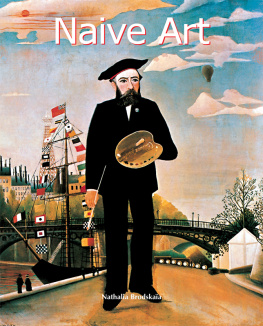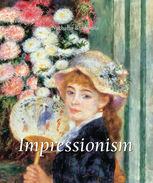Brodskaïa Nathalia - Post-Impressionism
Here you can read online Brodskaïa Nathalia - Post-Impressionism full text of the book (entire story) in english for free. Download pdf and epub, get meaning, cover and reviews about this ebook. publisher: Parkstone International, genre: Detective and thriller. Description of the work, (preface) as well as reviews are available. Best literature library LitArk.com created for fans of good reading and offers a wide selection of genres:
Romance novel
Science fiction
Adventure
Detective
Science
History
Home and family
Prose
Art
Politics
Computer
Non-fiction
Religion
Business
Children
Humor
Choose a favorite category and find really read worthwhile books. Enjoy immersion in the world of imagination, feel the emotions of the characters or learn something new for yourself, make an fascinating discovery.
- Book:Post-Impressionism
- Author:
- Publisher:Parkstone International
- Genre:
- Rating:3 / 5
- Favourites:Add to favourites
- Your mark:
- 60
- 1
- 2
- 3
- 4
- 5
Post-Impressionism: summary, description and annotation
We offer to read an annotation, description, summary or preface (depends on what the author of the book "Post-Impressionism" wrote himself). If you haven't found the necessary information about the book — write in the comments, we will try to find it.
Post-Impressionism — read online for free the complete book (whole text) full work
Below is the text of the book, divided by pages. System saving the place of the last page read, allows you to conveniently read the book "Post-Impressionism" online for free, without having to search again every time where you left off. Put a bookmark, and you can go to the page where you finished reading at any time.
Font size:
Interval:
Bookmark:
Nathalia Brodskaa
Post-Impressionism

Author: Nathalia Brodskaa
Translators: ATTA, Brengre Mauduit and Andrew Byrd for the translation of the quotations
Layout: Baseline Co Ltd
Baseline Co. Ltd
Ho Chi Minh City, Vietnam
Parkstone Press International, New York, USA
Confidential Concepts, Worldwide, USA
Pierre Bonnard, Artist Rights Society (ARS), New York, USA/ ADAGP, Paris
Maurice Denis, Artists Rights Society (ARS), New York, USA/ ADAGP, Paris
Ker Xavier Roussel, Artists Rights Society (ARS), New York, USA/ ADAGP, Paris
Edouard Vuillard, Artists Rights Society (ARS), New York, USA/ ADAGP, Paris
All rights reserved.
No part of this publication may be reproduced or adapted without the permission of the copyright holder, throughout the world. Unless otherwise specified, copyright on the works reproduced lies with the respective photographers. Despite intensive research, it has not always been possible to establish copyright ownership. Where this is the case, we would appreciate notification.
ISBN: 978-1-78525-658-5
Contents

Paul Czanne, Mont Sainte-Victoire, 1902-1904. Oil on canvas, 73 x 91.9 cm. Philadelphia Museum of Art, Philadelphia.
What is Post-Impressionism?
The term Post-Impressionism has only one meaning: after Impressionism. Post-Impressionism is not an art movement, nor an art style; it is a brief period at the end of the nineteenth century. Impressionism being a phenomenon unique to French painting, the idea of Post-Impressionism is also closely linked to French art. Generally, the beginning of the Post-Impressionist era dates from 1886, from the moment of the eighth and final joint Impressionist Art exhibition. The era ends after 1900, running only into the first decade of the twentieth century. Although Post-Impressionism and its chronological limits are well-defined, it seems that several Post-Impressionist works exist outside this period. Despite this periods extreme brevity, it is often described as an era of Post-Impressionism. In fact, this twenty-year period saw the emergence of such striking artistic phenomenon, such varying styles of pictorial art and such remarkable creative personalities, that these years at the turn of the century can without a doubt be characterised as an era.
During that period the Impressionists were still alive and working. After 1886 Claude Monet, Edgar Degas, Auguste Renoir, Camille Pissarro and Alfred Sisley created many new pieces, but the period of their creative unity, their joint quest and performances were things of the past. Like Edouard Manet, who died in 1883, they were becoming famous little by little, although official recognition was slow in coming. It seemed that the moment had come to ponder the very idea of Impressionism, to understand what it had brought to art at the time.
In 1886, a Parisian art critic, Flix Fnon, published a series of articles called Impressionists in 1886. Three years after the death of Edouard Manet, Fnon had already realised that it was not Manet who represented Impressionism. Edouard Manet had taught the Impressionists a lot, but his own bright and independent painting, had also been influenced at some point, in Fnons opinion: By Camille Pissarro, Degas, Renoir, and above all by Claude Monet: these were the leaders of the revolution of which he was the herald.
In 1886 the word Impressionists did not appear in the title of their exhibition. That exhibition was organised by Berthe Morisot, her husband Eugne Manet and Edgar Degas. From the very start of the artists association, Degas was opposed to the term Impressionism, coined by the critic Louis Leroy after the title of a Claude Monet painting. In fact, even from the first exhibition, no real unity existed amongst the artists exhibiting together. In an attempt to strengthen the group, they invited their friends to the first exhibition, friends who did not necessarily share the same orientation. However, the course of action at this and subsequent exhibitions was dictated by a core group: three of Gleyres students Monet, Renoir and Sisley together with Pissarro and Degas, who were joined by Berthe Morisot and some of her friends. Judging by the list of exhibitors, the final exhibition was no longer Impressionism. Neither Claude Monet nor Renoir participated, preferring instead to take part in Georges Petits Fifth International exhibition. In addition, irritated at not having been associated with the organisation of the exhibition, Sisley and Caillebotte, friends of the Impressionists, refused to exhibit. In their stead were new exhibitors who had nothing in common with Impressionism: Odilon Redon, Georges Seurat, Paul Signac, Paul Gauguin with his friend Emile Shuffenecker and others. Fnon attempted dividing the 1886 exhibitors into groups representing various tendencies. In his opinion Degas stood alone; traditional naturalistic Impressionism was represented by Berthe Morisot, Gauguin and Guillaumin; and finally, Pissarro, Seurat and Signac represented a new style. However, even Fnon, one of the most sensitive Parisian critics of the time, could not separate Impressionism from the other opposing styles that surrounded it and consequentially followed it. This is not surprising. At that time participants at these group exhibitions, artists such as Czanne and Gauguin, also appeared to belong to Impressionism.
Summary of Impressionism
It was Fnon, however, who first defined Impressionisms basic elements, which separated it from traditional painting. Impressionism has established a new vision in art, he wrote in 1886, summarising the work of Impressionists. () All historical, allegorical, mythological, or overly literary subjects are forbidden; Work is directly based on nature, and not performed in the studio based on memories, sketches, or written documents; Concern for the emotional significance of colours; An effort to approach brilliant, natural luminosity the Impressionist school is a school of colourists.
In literature Emile Zola made the first attempt at understanding Impressionism in his novel Luvre (The Masterpiece) published in Paris in 1886. An enthusiastic supporter of Edouard Manet, Zola wrote the story of a quest and fall of a young Impressionist artist. The heros biography corresponded to none of the Impressionists of the time. According to Zola, the painting depicted in this novel resembled The Luncheon on the Grass by Edouard Manet. The novels main character lived in the well-known bohemian atmosphere of Paris. His art rose in endless doubt and torment; he finally lost his mind and committed suicide. Zolas contemporaries tried guessing who the painter resembled most: Edouard Manet or Claude Monet? Only Paul Czanne, Zolas childhood friend, was convinced that he was the prototype for the character. Feeling betrayed, he broke off his friendship of nearly thirty years with the writer. In the end, the novel offended everyone Zola was too pessimistic in describing the work of the painter and in depicting his tragic fate. Without doubt it was still too early. For critics, supporters and the painters themselves, it was not yet time to comprehend Impressionisms impact on the art of that time and the effect it would have on the development of painting.
The term Post-Impressionism appeared much later, it acknowledged the major role Impressionism played in Art worldwide. This art movement was so spectacular that none of the then living artists following non-academic paths could avoid its influence. Whether a supporter or an adversary of Impressionism, no artist at the end of the nineteenth century could detach himself from what Monet and his friends had done. Impressionism was a powerful force in the development of pictorial tendencies opposing the diktat of canons from the classical school of painting; it rejected the base adopted during the Renaissance by European art on which were based first Italian then French academic dogma in the seventeenth, eighteenth and nineteenth centuries. Of course, the academic canons regarding professional training in the field of fine art were rigorously logical, rational and, it seems, everlasting. Novelty, however, was not born of negation, but rather of the utilisation of these rules as a basis for long-term development in painting. The freedom Impressionists allowed themselves revealed artistic paths of great diversity, and gave each painter the opportunity to make his own choice.
Font size:
Interval:
Bookmark:
Similar books «Post-Impressionism»
Look at similar books to Post-Impressionism. We have selected literature similar in name and meaning in the hope of providing readers with more options to find new, interesting, not yet read works.
Discussion, reviews of the book Post-Impressionism and just readers' own opinions. Leave your comments, write what you think about the work, its meaning or the main characters. Specify what exactly you liked and what you didn't like, and why you think so.













